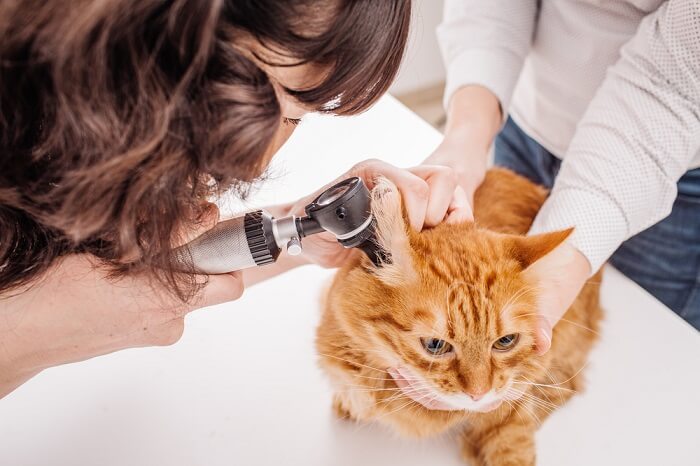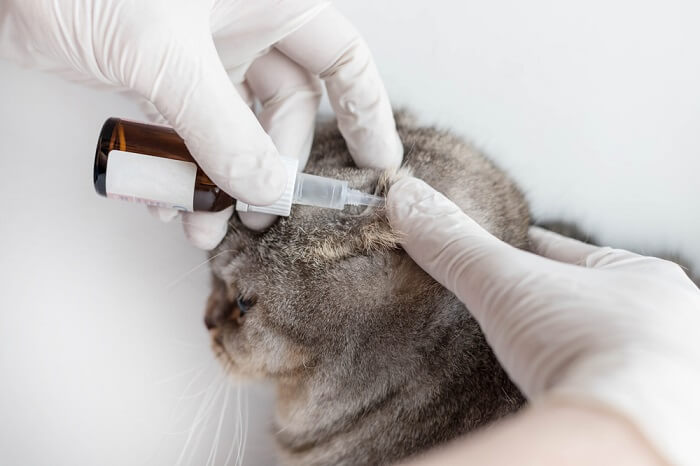
Most cats have adorable, active ears, constantly moving around and scanning the horizon for new sounds. In some cases, however, these lovable feline ears become infected, serving as a source of pain for cats. If this happens, it’s important to recognize the problem quickly and seek treatment, before you end up with a much larger problem on your hands.
Quick Overview: Cat Ear Infection
 Other Names: Otitis
Other Names: Otitis
 Common Symptoms: Scratching, head-shaking, rubbing the ear, bad odor from ears, blood or scabs present on ear, abnormal debris present in ears.
Common Symptoms: Scratching, head-shaking, rubbing the ear, bad odor from ears, blood or scabs present on ear, abnormal debris present in ears.
 Diagnosis: A swab sample from affected ear examined under a microscope (ear cytology), ear culture. Rarely, x-rays or more advanced imaging of the inner ear.
Diagnosis: A swab sample from affected ear examined under a microscope (ear cytology), ear culture. Rarely, x-rays or more advanced imaging of the inner ear.
 Requires Ongoing Medication: Yes (to address an underlying allergy that is often present)
Requires Ongoing Medication: Yes (to address an underlying allergy that is often present)
 Vaccine Available: No
Vaccine Available: No
 Treatment Options: Antibiotic and/or antifungal ear drops or ointment selected based on growth found on cytology, topical steroid to reduce ear inflammation and discomfort. Oral medication for allergies.
Treatment Options: Antibiotic and/or antifungal ear drops or ointment selected based on growth found on cytology, topical steroid to reduce ear inflammation and discomfort. Oral medication for allergies.
 Home Remedies: Ear cleaning at home with a cleaner made for pets at least once daily if a problem is noted may help, especially early.
Home Remedies: Ear cleaning at home with a cleaner made for pets at least once daily if a problem is noted may help, especially early.
What Is an Ear Infection?
An ear infection in cats typically involves inflammation of the external ear canal. This condition is also called otitis externa. While ear infections are a relatively common occurrence in dogs, they are (fortunately) less common in cats.
The feline ear has a number of components. Many of these components are protected by the ear drum, such as the middle ear and inner ear. Infections of the middle ear (otitis media) and inner ear (otitis interna) are less common in cats.
Instead, cat ear infections typically affect the external ear canal or outer ear, outside of the eardrum. The inflammation associated with an ear infection also commonly affects the pinna (ear flap).
Causes of Cat Ear Infections
Ear infections in cats can have many different causes. These causes include parasites, bacteria, yeast, or allergies. It’s important for your vet to determine the cause of your cat’s ear infection, in order to prescribe effective treatment.
The most common cause of ear infections in cats is ear mites. The parasite Otodectes cynotis is a tiny, bug-like parasite that is about the size of a pinhead. These mites feed on wax and skin cells within the ear, causing significant irritation. Cats acquire ear mites from close contact with another infected cat or dog.
Yeast and bacteria also contribute to cat ear infections. Unlike ear mites, yeast and bacterial infections are not contagious. Even healthy cat ears contain a small amount of yeast or bacteria.
These organisms only cause an infection when something upsets the balance within the ear. In some cases, inflammation caused by ear mites leads to a bacterial or yeast infection. In other cases, it is allergies that trigger inflammation and swelling within the ear, allowing bacteria and yeast to proliferate to greater-than-normal levels.
Less common causes of feline ear infections include foreign materials trapped in the ear canal, tumors, and polyps (benign swellings within the ear canal).
Symptoms of Ear Problems in Cats

The first sign of an ear infection is usually excessive scratching or rubbing at the ear.
Ear infections are uncomfortable and often itchy. The first sign that you are likely to notice is excessive scratching or rubbing at the ear. You might also notice head shaking, or that your cat is holding one or both ears in an unusual position. Some cats may hide or become less social, due to the discomfort of an ear infection.
When you look closer, you might notice that your cat’s pina is red and inflamed. The skin around your cat’s ear may also be red. You may even notice scratches or wounds, caused by pawing at the ears.
You might see a build-up of brown, black or yellow debris within the ear. In some cases, you might even smell a foul odor. Any of these can suggest an ear infection. You should schedule an appointment with your veterinarian as soon as possible.
Diagnosis of Ear Infections in Cats
When your cat shows signs of a possible ear infection, a veterinary visit is essential. Your veterinarian will begin by performing a thorough physical exam.
This includes an otoscopic exam, in which the veterinarian uses an instrument, called an otoscope, to look into your cat’s ear canal. An otoscopic exam will allow your veterinarian to look for a foreign body or masses within the ear canal. The veterinarian will also evaluate your cat’s eardrum. If your cat is extremely painful, sedation or anesthesia may be required.
Microscopic examination of the debris within your cat’s ear is often required to obtain a diagnosis. Your veterinarian will obtain a sample of debris on a cotton swab, then prepare slides that can be examined under the microscope. Ear mites, bacteria, and yeast can all be seen using the microscope.
In some cases, especially in the case of repeated ear infections, more advanced testing is necessary. Bacterial culture and sensitivity testing may be required to identify and address resistant infections. Allergy testing and food trials may be used to identify underlying allergic causes of recurrent infections. Imaging, such as radiography (x-rays), computed tomography (CT scan), or magnetic resonance imaging (MRI) may be recommended, to rule out middle or inner ear infections as well as tumors or polyps.
Ear Infection Treatment and Prognosis

If your cat has an ear infection, your veterinarian will prescribe antiparasitic medication, antibiotics, or another medication, depending on the type of infection.
Treatment of an ear infection varies, depending on what’s causing the infection. Ear mite infestation is treated with anti-parasite medications, which may be given systemically (usually applied via the skin) or applied directly to the ears with ear drops.
Bacterial infections require antibiotics, but the precise antibiotic that is used may vary based on what is seen on microscopic examination. Yeast infections are treated with an antifungal agent. Most ear drops contain a combination of antibiotic and antifungal drugs, combined with a corticosteroid to relieve pain and inflammation.
Cats with a chronic or severe ear infection may also be treated with oral or injectable medication. These medications can reduce the swelling and inflammation of the ear canal, allowing topical medications to work more effectively.
Ear cleaning is also a component of treating an ear infection. Removing excess debris from the ears helps the medication work effectively. Your veterinarian will also prescribe or recommend an appropriate ear cleaner for your cat. It’s important to not try cleaning your cat’s ears with ingredients you may have at home (such as hydrogen peroxide or rubbing alcohol) because they can be very painful and can actually worsen your cat’s ear infection.
Your veterinarian may also ask you to return for a recheck appointment in one to two weeks. This recheck ensures that your cat is responding to the prescribed treatment. If your cat is not responding as expected, your veterinarian may recommend further testing or may change medications.
In severe cases or chronic ear infections, more aggressive treatment may be necessary. This might involve ear cleanings performed under anesthesia or even surgery to remove a chronically infected ear canal that is not responding to treatment.
Conclusion
Ear infections are easiest to treat when they are detected early and addressed quickly. If you notice your cat scratching at his ears or notice any signs of redness or inflammation, contact your veterinarian quickly to schedule an appointment. Give any prescribed medications as directed and return for scheduled rechecks, in order to ensure that the infection is eliminated and does not become a chronic problem.
Frequently Asked Questions
How do you know if your cat has an ear infection?
In many cases, the first sign of an ear infection is scratching at the ears. Some cats may also shake their head or hold their ear differently than usual (keeping the ear flattened to the head or flicking the ear unusually).
Can an ear infection kill a cat?
While ear infections are not typically fatal in cats, they can cause permanent damage. If left untreated, ear infections can cause hearing loss. In some cases, an ear infection may be a sign of a more serious underlying condition, such as a tumor.
How long does an ear infection last in cats?
Most external ear infections in cats will resolve with approximately two weeks of treatment. Some cases may require long-term treatment, especially if the infection is affecting the middle ear or inner ear.
What can I do if my cat has an ear infection?
If you suspect that your cat might have an ear infection, schedule an appointment with your veterinarian. Your veterinarian can determine the cause of your cat’s infection, as well as an appropriate treatment.








Hi, I’ve been to the vet and they sa my cat has yeast in his ear. All I can do is clean his ear. Any recommendations for getting rid of the yeast in his ear for good?
Much appreciated!
In addition to relieving inflammation and itchiness, Zymox’s otic ear solution can help to resolve yeast infections in cats’ ears.